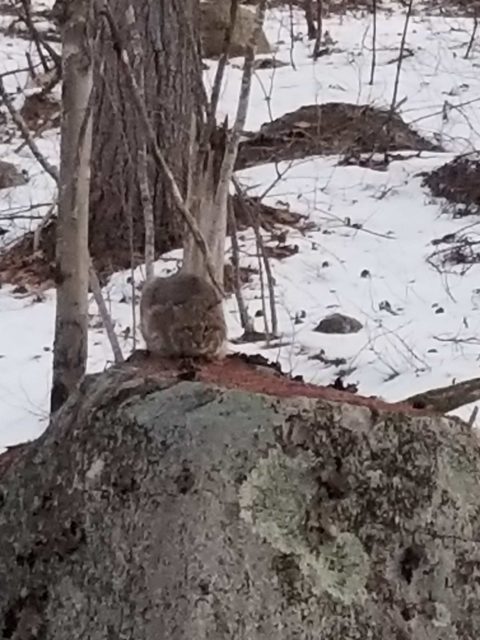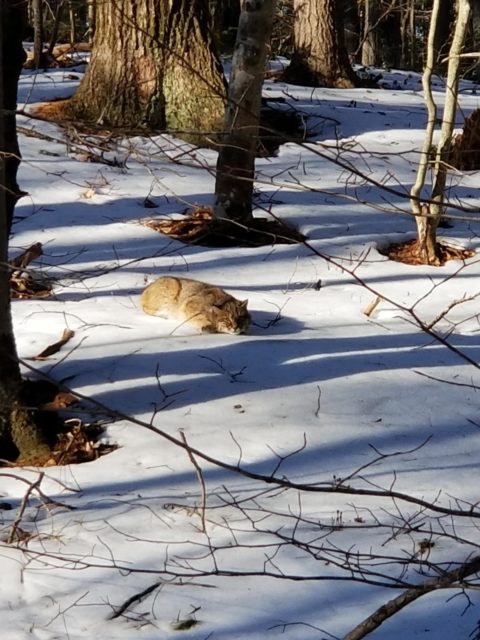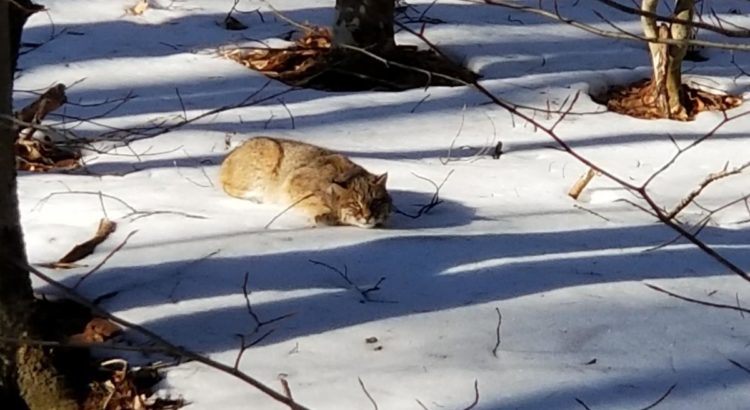By: Simone Maule, 2019 Student Conservation Association New Hampshire AmeriCorps Member
Animal sightings are always an exciting event here at Bear Brook State Park. Our entire corps was thrilled to have the opportunity to see a porcupine in action during one of our training weeks and the wildlife has kept on coming. As a collective group we’ve seen white-tailed deer, turkey vultures, flying squirrels, rabbits, turkeys, possums, hawks, voles, mice, red squirrels, and even some moose! But more recently we’ve had a new visitor to our backyard. Someone we’re very excited to see – we have our very own resident bobcat! We’ve had several sightings of the bobcat strolling around the woods, especially along the campground road. Given that we are all here to learn about the environment around us, this seemed like the perfect opportunity to find out a little bit more about our feline neighbor.

According to the New Hampshire Fish and Game Department, the bobcat (Lynx rufus) is the most common wildcat in North America, so it’s not that surprising that we would encounter one in this park. They are also well suited to living in mixed forests, so Bear Brook’s hemlock-northern hardwood environment is near perfect for this animal. In contrast to species that are nocturnal (active at night) or diurnal (active during the day) bobcats are crepuscular (coolest word ever!); this means that they are primarily active during the twilight hours of dawn and dusk. This fits with our observations as we have mostly seen the bobcat in the early morning hours. Bobcats are carnivorous predators and while their diet mainly consists of rabbits they also prey on mice, squirrels, voles, birds, and other small animals. We’ve seen this behavior in action as a few members of our community witnessed the bobcat stalking a squirrel that was feasting on food remnants near our compost bin.

One question that has come up is whether or not our multiple sightings were the work of just one bobcat or several. Bobcats are known for their expansive range which, depending on sex, can be anywhere from five to thirty square miles. In addition, they are solitary creatures which means it is likely that we have seen just one individual bobcat rather than several. The only caveat to this is that it is toward the end of the mating season for bobcats, so it’s possible that this bobcat is traveling outside of its range to look for a mate.

Now that it is warming up we’ll be on the lookout for more spring visitors. Stay tuned!
Pro Tip: Remember that, when observing wild animals, the best way to keep yourself and the wild animal safe is to maintain a proper and safe distance. You can use your thumb as a measuring tool for this purpose. All you need to do is extend your arm, raise your thumb, and close one eye. If your thumb can completely cover the animal in question you are at a safe distance; if your thumb cannot cover the animal – you’re too close!


WOW! It must be fun to spot him. So cute.
I love Bear Brook State Park. Been going there for 40 years straight. Yes I have seen bobcats there!!!
Saw one at the base of Mount Monadnock in February! Totally awesome!